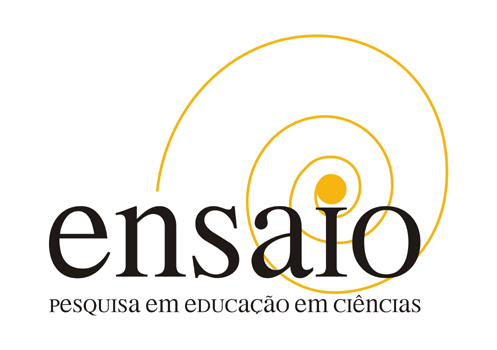Resumo:
Após revisão da literatura onde se define o conceito de modelo mental, apresentamos resultados de estudo sobre os modelos mentais de eletricidade, magnetismo e eletromagnetismo de seis grupos de indivíduos. Entre estudantes e profissionais com experiências de escolarização diversificadas, foram entrevistadas 56 pessoas. As entrevistas ocorreram enquanto se realizaram experimentos com imãs, eletroímãs e circuitos elétricos simples. Foram identificados quatro modelos de eletricidade, cinco de magnetismo e três para explicar o magnetismo no eletroímã. Apresentamos os dados desse estudo centrando atenção na evolução dos modelos identificados. Em nossa análise, destacamos quais aspectos dos modelos sofrem mudanças significativas à medida que os sujeitos ganham maior compreensão conceituai e experiência com os fenômenos estudados.
Texto completo disponível apenas em PDF.
Full text available only in PDF format.
Referências bibliográficas
- ANDERSSON, B. (1986). The experiential gestait of causation: A common core to pupils' preconceptions in science. European Journal of Science Education (3), pp. 155-171.
- BLISS, J. (1995). Piaget and after: the case of learning science. Studies in Science Education 25, 139-172,
- BORGES, A.T. (1996). Menta! Modeis of Electromagnetism Inglaterra: Universidade de Reading. (Tese de Doutorado).
- BORGES, A.T. (1997). Um estudo de Modelos Mentais. Investigações em Ensino de Ciências {online}. Vol. 1, No. 3. Disponível pela Internet: <http://www.if.ufrgs.br/public/ensino/>.
» http://www.if.ufrgs.br/public/ensino/ - BORGES, A.T. e GILBERT, J.K. (1998) Modeis of magnetism. Internationa Journal of Science Education Vol. 20, No. 3, 361-378.
- BREWER, W. (1987). Schemas versus mental modeis in human memory. In P. Morris (Ed.), Modeiling Cognition Chichester: John Wiley. pp. 187-197.
- CARROLL, J. M. (1991). Designing Interaction; Psychology at the Human Computer Interface. Cambridge: Cambridge University Press.
- CARROLL, J.M.; OLSON, J.R. (1988). Mental modeis in human-computer interaction. In M. Helander (Ed.). Handbook of Human-Computer Interaction Amsterdam: Elsevier.
- COLLINS, A. e GENTNER, D. (1987). How people construct mental modeis. In D. Holiand e N. Quinn (Eds.) Cultural Models in Language and Thought Cambridge: Cambridge University Press. pp. 243-265.
- CLOSSET, J.L. (1983). Sequential reasoning in electricity, In: International Workshop of Research on Physics Education, 1, 26/06-13/07/83, La Londe lês Maures (FR). Proceedings of the. First... Paris: Editions du CNRS. pp. 313-319.
- de KLEER, J.; BROWN, J.S. (1981). Mental model of physical mechanisms and their acquisition. In J.R. ANDERSON (Ed.), Cognitive Skills and Their Acquisition. Hilisdale (NJ): Lawrence Eribaum. pp. 258-310.
- de KLEER, J.; BROWN, J.S. (1983). Assumptions and ambiguities in mechanistic mental models. In D. GENTNER and A.L. STEVENS (Eds). Mental Models.. Hillsdale(NJ): Lawrence Eribaum. pp.155-190.
- DRIVER, R., LEACH, J., SCOTT, P. and WOOD-ROBINSON, V. (1994). Young people's understanding of science concepts: Implications of cross-age studies for curriculum planning. Studies in Science Education Vol. 24, pp. 75-100.
- DUIT, R., JUNO, W. and RHONECK, C.V. (Eds.) (1985). Aspects of Understanding Electricity. Kiel, Germany: IPN.
- GENTNER, D. and GENTNER, D. R. (1983). Flowing waters or moving crowd: Mental models of electricity. In D. GENTNER and A. L. STEVENS (Eds.),. Mental Models Hilisdale, NJ: Lawrence Eribaum. pp. 99-130.
- GENTNER, D. and STEVENS, A.L. (1983). Mental Models Hilisdale, NJ: Lawrence Eribaum.
- GIERE, R.N. (1988). Explaining Science: A Cognitive Approach. Chicago: The University of Chicago Press.
- HAUPT, G.W. (1952). Concepts of magnetism held by elementary school children. Science Education 36, pp. 162-168.
- HAYES, P.J. (1985). Naïve physics 1: Ontology for liquids. In J.R. HOBBS e R.C. MOORE (Eds.) Formal Theories of the Commonsense World Norwood: Ablex Publishing Co.. pp.71-107.
- JOHNSON-LAIRD, P. (1983).. Mental Models Cambridge, MA: Harvard University Press.
- MAYER, R.E. (1989). Models for understanding. Review of Educational Research, 59 (1), pp. 43-64.
- MAYER, R.E. (1992). Knowledge and thought: Mental models that support scientific reasoning. In: R.A. DUSCHL and R.J. HAMILTON (eds.) Philosophy of Science, Cognitive Psychology and Educational Theory and Practice. Albany(NY): SUNY Press. pp. 226-243.
- OSBORNE, R. (1983). Towards modifying children's ideas about electric current. Research in Science and Technology Education Vol. 1 (1), pp. 73-82.
- PAYNE, S.J. (1991). On mental models and cognitive artefacts. In Y. Rogers, A. Rutherford e P.A. Bibby (Eds.) Models in the Mind London: Academic Press. pp. 103-118.
- PIAGET, J. and GARCIA, R. (1989). Psychogenesis and the History of Science New York: Columbia University Press.
Datas de Publicação
-
Publicação nesta coleção
Jun 1999

